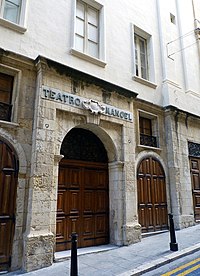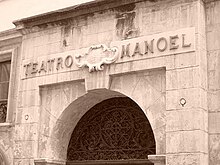Manoel Theatre
Teatro Pubblico (1732–1800) Teatro Reale (1800–1873) | |
 Façade of Teatru Manoel | |
 | |
| Address | 115, Old Theatre Street Valletta Malta |
|---|---|
| Designation | Grade 1 listed building |
| Capacity | 623 |
| Construction | |
| Opened | 1732 |
| Years active | 1732–present |
| Architect | Antonio Azzopardi and Francesco Zerafa[1] |
| Website | |
| teatrumanoel.com.mt | |

Teatru Manoel (
The theatre is located on Old Theatre Street (Maltese: Triq it-Teatru l-Antik) in
The theatre is a small, 623 seat venue, with an oval-shaped auditorium, three tiers of boxes constructed entirely of wood, decorated with gold leaf, and a pale blue trompe-l'œil ceiling that resembles a round cupola. The building is a Grade 1 listed building as noted by Malta's Superintendence of Cultural Heritage, and is also scheduled by the Malta Environment and Planning Authority (MEPA).[3]
History

Before the construction of the theatre, plays and amateur theatrical productions were staged in the halls and piano nobiles of the Knights' auberges. These were palaces constructed for the langues of the Order. The Langue of Italy often held such entertainment, staged by its knights in their Auberge. The records of the Langue even state that, on 2 February 1697, some Maltese gentlemen presented a play in the Auberge d'Italie. Women were prohibited from attending these events after incidents during the Carnival festivities of 1639.

In 1731,
Construction was finished in only ten months. This however, may be because alterations were made to the fabric of the three adjoining houses, incorporating them into a theatre. The building occupied an area of 94½ square canes,[n 3] which was later altered to 93 square canes and 2½ palms.[n 4][7] The theatre is said to have been modelled after the contemporary Palermo Theatre.[8] Its auditorium was originally semi-circular or horseshoe shaped, with an illuminated parterre that served as a small dance floor. The first theatrical performance to be staged at the Teatro Pubblico was Scipione Maffei's classic tragedy Merope, on 9 January 1732.[9] The actors in that production were the Knights themselves, and the set was designed by the Knights' chief military architect, Francois Mondion.[10]

On 26 January 1732 a satirical and anti-clerical play "Il bacchettiere falso" by Girolamo Gigli was performed. On 18 January 1769 the play "Il trionfo di Minerva", by Lentisco Adrasteo was presented on the occasion of
In its early days, the management of the theatre, and censorship of its performances, was entrusted to a senior knight, known as the Protettore.

Nicolas Isouard's first known opera, Casaciello perseguitato da un mago, was performed here in 1792, and Isouard became director of this theatre in 1798, after the French captured Malta, and continued to premiere other operas there.[5][14] Several of Isouard's own works, including Avviso ai Maritati and Artaserse, were performed at the Manoel during this time. French rule over Malta was short-lived and within two years the islands passed into the hands of Great Britain. An English gentleman who accompanied Abercrombie's expedition to Egypt in 1801, wrote that:
"La Valette possesses an opera, small indeed, but neat, though much out of repair. Italy and Sicily supply it with very tolerable vocal performers, and it is a very agreeable entertainment for the garrison. It was excessively crowded every night by the officers of the expedition, to whom it was a great source of amusement. The price of admission is one shilling."[15]

During the early

In 1861, the Teatro Reale was given on perpetual lease, by the government, to Dr. Salvatore Mifsud and Anacleto Conti for an annual ground rent of £236,15, and in 1862, the directum dominium was sold to Emmanuele Scicluna for £7,833.6.8.
The theatre was included on the Antiquities List of 1925.[18]
Present day
Despite numerous alterations over the years, it retains many of its old architectural features, such as the white
Following the destruction of the

The theatre is being restored by the Teatru Manoel Restoration Committee.[22] Previous restoration attempts done in the 1970s were heavily criticised, with the removal of a balcony and the reinforcement of old stone with new masonry.[23] The first phase of the new restoration took place in 2003, and included the restoration of the paintings on the frontispiece of the auditorium boxes.[24] In 2004, the auditorium was restored by a team of Sante Guido Restauro e Conservazione di Opere d'Arte, who unearthed paintings that will allow the understanding of the theatre's development.[3][25] This second phase included the cleaning of the gilt.[24] The third phase included the restoration of the proscenium arch and the boxes it incorporates, while the fourth phase of the restoration project was the ceiling's restoration, which was inaugurated on 3 October 2006.[24] Although controversial,[5][26] an application to restore the theatre's façade was approved by Maltese planning and heritage supervisory bodies[23] and was restored in 2017.[27]
Today, Teatru Manoel continues to put up a broad variety of theatrical productions in both English and Maltese, opera, musical recitals (including lunchtime recitals in Sala Isouard),[28] poetry recitals, dramatic readings, and an annual Christmas pantomime, produced by the Malta Amateur Dramatic Club. Management of the theatre is currently entrusted to Acting-CEO Edward Zammit, until a new Artistic Director has been chosen. The Board is made up of Chairman Dr. Michael Grech, Deputy Chairman Anita Aloisio, and Board Members Carmel Farrugia, Lilian Pace Vassallo, Dr. Zaid Teebi, Victor Spiteri, Julian Guillaumier, Mario Caruana, Jurgen Briffa, John Schembri and Luke Cassar.[29] Many productions are regularly presented, both by local talent and international stars, and the theatre has been a source for the cultural appreciation of the arts in Malta.[20] Since 1960, it has had an official Management Committee and is no longer rented out for whole seasons to impresarios as in the past. The theatre's musical programmes retain some variety, but the main emphasis during recent decades has been on instrumental music.[20]
The theatre is listed on the National Inventory of the Cultural Property of the Maltese Islands.[3]
World premieres held at Teatru Manoel (incomplete)
- 8 April 2016: The Price of One. Play by Edward Bond. Directed by Chris Cooper.[30][31]
- 26 January 2017: Concertino for guitar, harpsichord and orchestra by Reuben Pace. Malta Philharmonic Orchestra, Michelle Castelletti (conductor), Johanna Beisteiner (guitar), Joanne Camilleri (harpsichord).[32]
Notable visitors
Many opera singers, musicians and troupes have graced its stage. These include Boris Christoff, Mirella Freni, Rosanna Carteri, Cecilia Gasdia, Louis Kentner, Flaviano Labò, Dame Moura Lympany, Sir Yehudi Menuhin, John Neville, Magda Olivero, Michael Ponti, Katia Ricciarelli, Mstislav Rostropovich, Dame Margaret Rutherford, Steve Hackett, Dame Kiri Te Kanawa and Sir Donald Wolfit.[33] Visiting companies at Teatru Manoel have included Nottingham Playhouse, the Comédie-Française and the Staatsballett Berlin (Berlin State Opera Ballet).[33]
Notes
- ^ This phrase was inscribed above the main entrance to the theatre,[5] which still reads to this today: "Ad honestam populi oblectationem."(in Latin)
- ^ Vilhena also paid a further 2,000 scudi for the reconstruction of the Navarrese knights' two remaining houses, which then became known as the New Priory of Navarre.[6]
- ^ 496.31 square yards (415 m2)
- ^ 488.64 square yards (409 m2)
References
- ^ "Info" (PDF). melitensiawth.com. Retrieved 2019-11-08.
- ^ a b "Manoel Theatre". Valletta – Living history. Archived from the original on 17 December 2014. Retrieved 1 March 2014.
- ^ a b c d e f "National Inventory of the Cultural Property of the Maltese Islands" (PDF). Superintendence of Cultural Heritage. 28 December 2012. Archived from the original (PDF) on March 6, 2014. Retrieved 28 February 2014.
- ^ "Data" (PDF). melitensiawth.com. Retrieved 2019-11-08.
- ^ a b c d e f g "Manoel Theatre façade to be restored". The Malta Independent. 26 September 2013. Retrieved 1 March 2014.
- ^ Repertorio Fondazione Manoel, R.M.K. Treas. A. 25 fo. 65.
- ^ a b c d e f g h i Denaro, Victor (1960). "The Manoel Theatre". Melita Historica. 3 (1): 1–4.
- ^ Scicluna, Sir Hannibal P., "Buildings and Fortifications of Valletta", in Malta and Gibraltar; London, W.H. & L. Collingridge, at p. 215
- ^ Compendio del Giornale del Sac. Fra. Gaetano Rebout. R.M.L., Ms. 20.
- ^ a b c "The Opera Page". Wix.com. Retrieved 28 February 2014.
- ^ "Tal-Manoel iridu joħorġu minn Palazzo Bonici sas-Sajf - TVM". Archived from the original on 2015-12-26. Retrieved 2015-12-25.
- ^ a b "The Beginning". Teatru Manoel. Retrieved 1 March 2014.
- ^ Diverse Scritture relative alla Fondazione Manoel, R.M.L., Treas. A. 32, cited by Denaro (1960), p. 2.
- ^ Paul Xuereb, The Manoel Theatre, a short history, Valletta, Friends of the Manoel Theatre
- ^ Walsh, Thomas (1803). Journal of the Late Campaign in Egypt: Including Descriptions of that Country, and of Gibraltar, Minorca, Malta, Marmorice, and Macri; with an Appendix; Containing Official Papers and Documents. Egypt: T. Cadell and W. Davies. p. 3.
- ^ Rolandi, Ulderico, "Musica e Musicisti in Malta", in Archivio Storico di Malta, Vol. I, Fasc. I, page 20, cited by Denaro (1960), p. 3.
- ^ Records of Notary Luigi Vella of 5 May 1861, and of 9 September 1802, cited by Denaro (1960), p. 4.
- ^ "Protection of Antiquities Regulations 21st November, 1932 Government Notice 402 of 1932, as Amended by Government Notices 127 of 1935 and 338 of 1939". Malta Environment and Planning Authority. Archived from the original on 19 April 2016.
- ISBN 978-0857286833.
- ^ a b c "The 20th Century". Teatru Manoel. Retrieved 1 March 2014.
- ^ a b Cooke, Patrick (4 September 2013). "Government breached noble's property rights". Times of Malta. Retrieved 1 March 2014.
- ^ "Third Phase of Manoel Theatre's restoration". The Malta Independent on Sunday. 12 June 2005. Retrieved 1 March 2014.
- ^ a b Grima, Noel (12 October 2012). "Manoel Theatre Façade restoration sees applicant and Mepa clash on cladding". The Malta Independent. Retrieved 1 March 2014.
- ^ a b c Parquet, Karine (24 September 2006). "The Restoration of the Manoel Theatre". The Malta Independent on Sunday. Retrieved 1 March 2014.
- ^ "Restoration". Teatru Manoel. Retrieved 1 March 2014.
- ^ Grima, Noel (15 November 2012). "Mepa approves Manoel Theatre restoration, except for façade". The Malta Independent. Retrieved 1 March 2014.
- ISBN 978-99957-58-15-8.
- ^ "Sala Isouard". Teatru Manoel. Retrieved 1 March 2014.
- ^ "New board of directors for Manoel Theatre". The Malta Independent. 29 March 2013. Retrieved 1 March 2014.
- ^ World premiere of „The Price of One“ at the Manoel Theatre. Article in Times of Malta, March 31, 2016. (English)
- ^ Powerful Bond. article by Veronica Stivala in Times of Malta, April 3, 2016.
- ^ A baroque world premiere. Article by Iggy Fenech, Times of Malta, 22 January 2017. (English)
- ^ a b "Theatre". Teatru Manoel. Archived from the original on 21 November 2012. Retrieved 1 March 2014.
External links
- Teatru Manoel – Official website
- Orkestra Filarmonika Nazzjonali – Official website
- Dwal Godda Theatre Company

